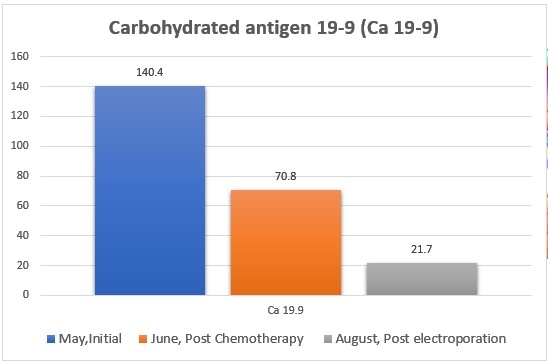IRREVERSIBLE ELECTRONANOPORATION, A BRIDGING TREATMENT IN THE MANAGEMENT OF LOCALLY ADVANCED PANCREATIC ADENOCARCINOMA
José David C. Zamora1, Layla Lissette Monroy Velasco1, Gloria C. Salgado1, Maria Fernanda Arboleda1, Eduardo E. Montalvo-Javé3, Yukiyoshi K. Fujikami2, Alejandro Rossano García*1
1Surgery, Hospital Angeles Pedregal, Mexico City, Mexico City, Mexico; 2CT Scanner Lomas Altas, Mexico, Mexico; 3Medica Sur, Ciudad de Mexico, Distrito Federal, Mexico
Introduction
Pancreatic adenocarcinoma is the seventh cause of death worldwide, with a 10% of survival to five years and a high mortality rate. Surgical treatment is the option with the highest survival rate. In patients with locally advanced stage, irreversible electroporation (IRE) is a safe and effective treatment due to its non-thermal lesion mechanism that acts with pulsed high voltage and low frequency currents transmitted by electrodes that disintegrate the cell membrane. It has shown less tumor progression, with a complication rate of 10-37% and a survival of up to fourteen months.
Case presentation
A 53 year old man with diffuse abdominal pain, early satiety and singultus. An abdominal CT shows a solid tumor in the head of the pancreas, a cystic lesion and Ca 19-9 elevation of 140.4 U/mL. ERCP and endoscopic ultrasound with biliary prosthesis placement and biopsy taken showed a differentiated infiltrating ductal adenocarcinoma. Three sessions of chemotherapy with Folfirinox were carried out. A 3D angiotomography was done to complement, it showed involvement of the proximal portion of the celiac trunk: T3, N1, M0.
At the surgical approach a subdiaphragmatic biopsy was taken, indicating well differentiated metastasis and appreciating the tumor lesion it was decided to perform IRE, with the use of transoperative ultrasound guidance, three antennas of 15 cm in length were placed in the tumor, separated by 1.5 cm and 30 cycles of 2700 mV were applied. One month later, tomography showed a decrease in tumor size of approximately 60% and a Ca 19-9 value of 21.7 U/mL. Currently the patient is completing three more cycles of chemotherapy, with clinical improvement and decrease of initial symptoms with moderate functional deterioration.
Discussion
IRE is a therapeutic option in advanced stages of pancreatic adenocarcinoma that are unresectable. An improvement in overall survival has been described with the combination of treatment with IRE and Folfirinox chemotherapy.
As we have observed in this patient and in retrospective studies performed in several hospitals, IRE is an innovative and effective treatment; a significant decrease in Ca 19-9 levels and tumor size was obtained, and this response was maintained for more than four months post-electroporation.
Conclusions
IRE is considered a bridge treatment in unresectable stages of pancreas cancer, in combination with other actual treatments, according to its safety and efficacy it provides a better local control of the tumor and an increase in patient survival.
Ca 19-9 follow up
3D Angio TAC and ultrasound showing mesoportal and celiac trunk involvement, and antennas placemente for the IRE
Back to 2022 Posters
